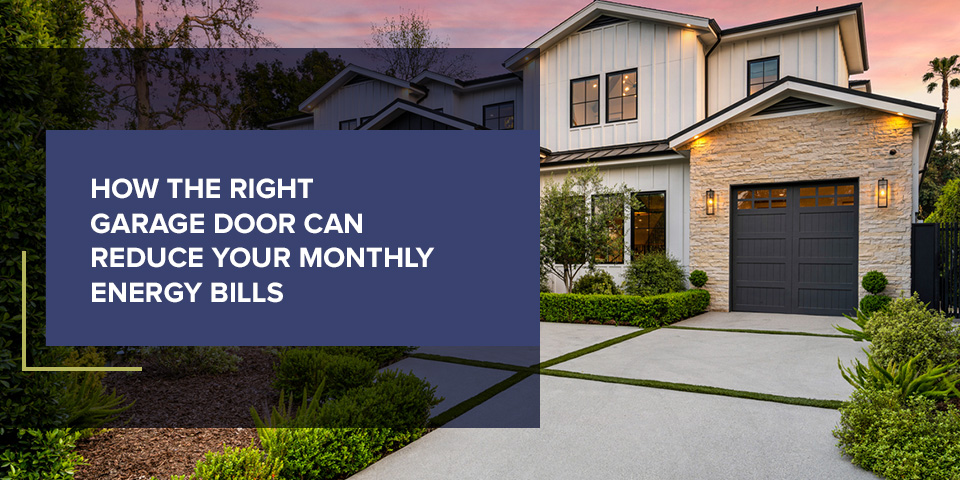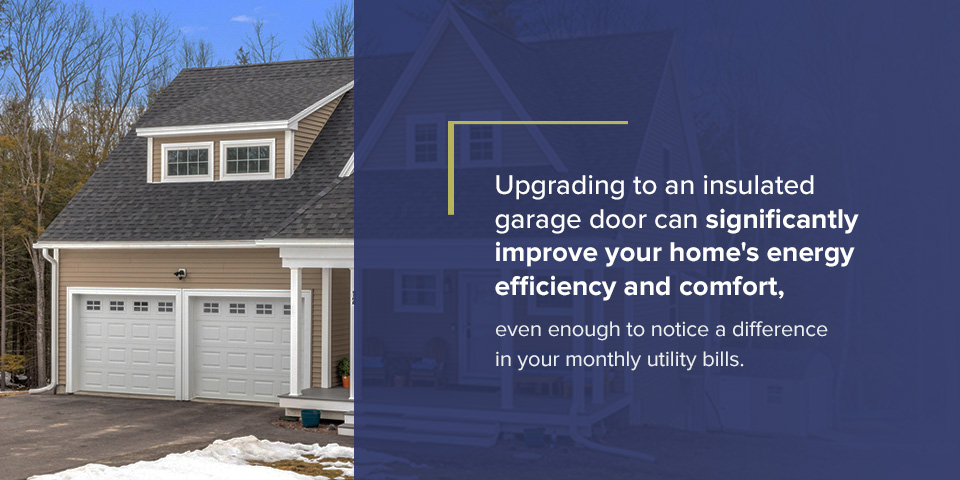
If you’re looking for ways to improve your home’s energy efficiency, consider starting with your garage door — it’s a key area for potential savings. As one of the largest openings in your home, your garage door can significantly impact your overall energy use, especially if your garage is attached to your living space.
A properly insulated and sealed garage door is a barrier against outside temperatures, helping maintain consistent indoor conditions and easing the load on your HVAC system. That means less energy use and lower monthly bills. Whether you’re building a new home or upgrading an existing garage, choosing the right door can deliver energy savings and comfort for the near future.
Table of Contents
Understanding Garage Door Insulation and R-Value
When evaluating garage doors for energy efficiency, R-value is one of the most important elements to consider. This number measures the door’s ability to resist heat flow. The higher the R-value, the better the insulation. A higher R-value means your garage is better equipped to keep warm air in during the winter and out during the summer. The Department of Energy provides detailed information on R-value and insulation standards.
Types of Insulation Materials
There are two common types of insulation used in garage doors:
- Polystyrene: This rigid foam insulation, also known as Styrofoam, is often inserted between the layers of a garage door. While cost-effective and lightweight, polystyrene generally offers lower R-values compared to polyurethane.
- Polyurethane: This high-performance insulation is injected between the layers of the garage door, expanding to fill the entire cavity. It offers superior thermal resistance and structural strength, making it an energy-efficient choice.
Insulated vs. Uninsulated Garage Doors
An uninsulated garage door offers little to no resistance to temperature fluctuations, essentially turning your garage into a giant heat sink. During winter, it can allow cold air to seep in, making adjacent rooms colder and increasing your heating bills. In the summer, heat from the garage can radiate into your home, forcing your air conditioner to work harder.
In contrast, an insulated garage door creates a thermal barrier that helps stabilize indoor temperatures. This barrier is particularly beneficial for attached garages or those used as workshops, home gyms or laundry rooms.
Many homeowners wonder if they really need an insulated garage door. Upgrading to an insulated garage door can significantly improve your home’s energy efficiency and comfort, even enough to notice a difference in your monthly utility bills.

Features and Benefits of Energy-Efficient Garage Doors
When shopping for an energy-efficient garage door, it’s important to understand what to look for. Modern doors offer a range of features specifically designed to minimize energy loss and withstand seasonal temperature changes. Here are a few key features to consider:
- Insulation type and thickness: Look for doors with polyurethane insulation and a high R-value, such as R-12 to R-18 for residential use. Thicker insulation improves performance and durability.
- Multilayer construction: Energy-efficient doors typically have two or three layers made from steel or aluminum outer layers with an insulated core. This design improves thermal performance while enhancing noise reduction and structural integrity.
- Weather stripping and bottom seals: High-quality garage doors include flexible weather seals around the frame and along the bottom edge. These components block air drafts, moisture, dust and pests from entering your garage.
- Thermal breaks: Some advanced models include thermal breaks, which are nonconductive materials between layers, to prevent heat or cold from transferring through the door’s structure.
These elements reduce heat transfer and air leakage, two major contributors to energy loss. When your garage door helps keep outdoor temperatures at bay, your home’s heating and cooling system has less stress. That translates to fewer energy spikes, less wear on your HVAC equipment and lower monthly bills.
Practical Tips on How to Save Energy in the Garage
While choosing an energy-efficient garage door is a smart move, pairing it with energy-conscious habits and upkeep can further boost your savings. Here are some practical tips every homeowner can follow.
1. Maintain Weather Seals
Check the seals around your garage door regularly for signs of wear, cracking or gaps. Damaged seals allow drafts and moisture to enter the garage, undoing the benefits of your insulated door. Replacing worn seals is a low-cost fix that can pay off in better insulation.
2. Use Your Door Responsibly
Leaving the garage door open, especially in extreme weather, lets conditioned air escape and invites outdoor air in. Try to limit the amount of time your garage door stays open to maintain interior temperature stability.
3. Insulate the Garage Walls and Ceiling
An energy-efficient garage door works best when it’s part of a broader insulation strategy. Insulating your garage walls and ceiling can help trap heat and make the space more comfortable year-round. This extra insulation is especially important if your garage shares a wall with a frequently used room.
4. Upgrade Your Garage Lighting
Swap out old incandescent bulbs with LED lighting, which uses significantly less electricity and generates less heat. This small switch can reduce your overall energy consumption and lower utility costs.
How Can You Make Your Garage Door More Energy-Efficient?
Replacing a whole garage door can put strain on your budget. Here are a few retrofit options that can help improve energy performance on your current setup. These upgrades are a budget-friendly way to reduce energy loss, especially if your current door is in good shape. Over time, these small improvements can lead to meaningful energy savings.
1. Add an Insulation Kit
Garage door insulation kits are available for most standard doors and typically use either polystyrene or reflective foil. While factory-insulated models are more effective, this option still significantly improves temperature regulation.
2. Replace Weather Stripping
Installing new perimeter weather stripping and a bottom door seal can close off air leaks and improve insulation. This is an affordable DIY project that delivers immediate results.
3. Install a Threshold Seal
When installed on the garage floor, threshold seals block drafts, rain and insects, particularly in older homes with uneven floors.
Discover Your Energy Savings
An energy-efficient garage door is more than just a smart home upgrade — it’s a practical investment in your home’s comfort and your long-term energy savings. From high R-values and multilayer insulation to tight weather seals and thermal barriers, today’s garage doors are engineered for performance.
Ready to experience the benefits of an energy-efficient garage door? Our experienced technicians are ready to help! Contact Crawford Door Sales today for a free consultation and quote. You can also call us at 651-455-1221 or visit us to talk to one of our garage door experts.


